Construction of Ag3PO4/SnO2 Heterojunction on Carbon Cloth with Enhanced Visible Light Photocatalytic Degradation
Abstract
1. Introduction
2. Experimental
2.1. Synthesis of SnO2 Nanorods on Carbon Cloth
2.2. Synthesis of Ag3PO4/SnO2 Heterojunction on Carbon Cloth
2.3. Characterization
2.4. Photocatalytic Activity
3. Results and Discussion
3.1. Microstructure and Morphology
3.2. Photocatalytic Performance
4. Conclusions
Supplementary Materials
Author Contributions
Funding
Conflicts of Interest
References
- Xue, H.; Chen, Q.; Jiang, F.; Yuan, D.; Lv, G.; Liang, L.; Liu, L.; Hong, M. A regenerative metal-organic framework for reversible uptake of Cd (II): From effective adsorption to in situ detection. Chem. Sci. 2016, 7, 5983–5988. [Google Scholar] [CrossRef] [PubMed]
- Desai, A.V.; Manna, B.; Karmakar, A.; Sahu, A.; Ghosh, S.K. A water-stable cationic metal-organic framework as a dual adsorbent of oxoanion pollutants. Angew. Chem. Int. Ed. 2016, 55, 7811–7815. [Google Scholar] [CrossRef] [PubMed]
- Duan, S.; Li, J.; Liu, X.; Wang, Y.; Zeng, S.; Shao, D.; Hayat, T. HF-free synthesis of nanoscale metal-organic framework NMIL-100(Fe) as an efficient dye adsorbent. ACS Sustain. Chem. Eng. 2016, 4, 3368–3378. [Google Scholar] [CrossRef]
- Wang, B.; Lv, X.-L.; Feng, D.; Xie, L.-H.; Zhang, J.; Li, M.; Xie, Y.; Li, J.-R.; Zhou, H.-C. Highly stable Zr(IV)-based metal–organic frameworks for the detection and removal of antibiotics and organic explosives in water. J. Am. Chem. Soc. 2016, 138, 6204–6216. [Google Scholar] [CrossRef]
- Xu, P.; Shen, X.; Luo, L.; Shi, Z.; Liu, Z.; Chen, Z.; Zhu, M.; Zhang, L. Preparation of TiO2/Bi2WO6 nanostructured heterojunctions on carbon fibers as a weaveable visible-light photocatalyst/photoelectrode. Environ. Sci. Nano. 2018, 5, 327–337. [Google Scholar] [CrossRef]
- Li, Y.-F.; Liu, Z.-P. Particle size, shape and activity for photocatalysis on titania anatase nanoparticles in aqueous surroundings. J. Am. Chem. Soc. 2011, 133, 15743–15752. [Google Scholar] [CrossRef]
- Li, Z.; Luo, W.; Zhang, M.; Feng, J.; Zou, Z. Photoelectrochemical cells for solar hydrogen production: Current state of promising photoelectrodes, methods to improve their properties, and outlook. Energy Environ. Sci. 2013, 6, 347–370. [Google Scholar] [CrossRef]
- Huang, Q.; Li, J. Enhanced photocatalytic and SERS properties of ZnO/Ag hierarchical multipods-shaped nanocomposites. Mater. Lett. 2017, 204, 85–88. [Google Scholar] [CrossRef]
- Chen, X.; Liu, L.; Yu, P.Y.; Mao, S.S. Increasing solar absorption for photocatalysis with black hydrogenated titanium dioxide nanocrystals. Science 2011, 331, 746–750. [Google Scholar] [CrossRef]
- Li, X.; Xia, T.; Xu, C.; Murowchick, J.; Chen, X. Synthesis and photoactivity of nanostructured CdS–TiO2 composite catalysts. Catal. Today 2014, 225, 64–73. [Google Scholar] [CrossRef]
- Liu, M.; Xu, P.; Zhang, J.; Liu, B. Preparation of MoS2@ZnO heterostructure with enhanced photocatalytic activity. Mater. Res. Express. 2019, 6, 045504. [Google Scholar] [CrossRef]
- Du, Y.; Zhang, N.; Wang, C. Photo-catalytic degradation of trifluralin by SnO2-doped Cu2O crystals. Catal. Commun. 2010, 11, 670–674. [Google Scholar] [CrossRef]
- Zhang, T.; Liu, Y.; Rao, Y.; Li, X.; Yuan, D.; Tang, S.; Zhao, Q. Enhanced photocatalytic activity of TiO2 with acetylene black and persulfate for degradation of tetracycline hydrochloride under visible light. Chem. Eng. J. 2020, 384, 123350. [Google Scholar] [CrossRef]
- Wei, R.-B.; Huang, Z.-L.; Gu, G.-H.; Wang, Z.; Zeng, L.; Chen, Y.; Liu, Z.-Q. Dual-cocatalysts decorated rimous CdS spheres advancing highly-efficient visible-light photocatalytic hydrogen production. Appl. Catal. B 2018, 231, 101–107. [Google Scholar] [CrossRef]
- Xu, J.-W.; Gao, Z.-D.; Han, K.; Liu, Y.; Song, Y.-Y. Synthesis of magnetically separable Ag3PO4/TiO2/Fe3O4 heterostructure with enhanced photocatalytic performance under visible light for photoinactivation of bacteria. ACS Appl. Mater. Interfaces 2014, 6, 15122–15131. [Google Scholar] [CrossRef]
- Liu, L.; Qi, Y.; Lu, J.; Lin, S.; An, W.; Liang, Y.; Cui, W. A stable Ag3PO4@g-C3N4 hybrid core@shell composite with enhanced visible light photocatalytic degradation. Appl. Catal. B 2016, 183, 133–141. [Google Scholar] [CrossRef]
- Li, N.; Miao, S.; Zheng, X.; Lai, J.; Lv, S.; Gu, X.; Zhang, M.; Yang, J.; Cui, S. Construction of Ag3PO4/BiNbO4 heterojunction photocatalysts with high activity for rhodamine B removal under simulated sunlight irradiation. Ceram. Int. 2019, 45, 24260–24268. [Google Scholar] [CrossRef]
- Shao, N.; Wang, J.; Wang, D.; Corvini, P. Preparation of three-dimensional Ag3PO4/TiO2@MoS2 for enhanced visible-light photocatalytic activity and anti-photocorrosion. Appl. Catal. B 2017, 203, 964–978. [Google Scholar] [CrossRef]
- Chen, F.; Yang, Q.; Li, X.; Zeng, G.; Wang, D.; Niu, C.; Zhao, J.; An, H.; Xie, T.; Deng, Y. Hierarchical assembly of graphene-bridged Ag3PO4/Ag/BiVO4 (040) Z-scheme photocatalyst: An efficient, sustainable and heterogeneous catalyst with enhanced visible-light photoactivity towards tetracycline degradation under visible light irradiation. Appl. Catal. B 2017, 200, 330–342. [Google Scholar] [CrossRef]
- Liu, L.; Ding, L.; Liu, Y.; An, W.; Lin, S.; Liang, Y.; Cui, W. A stable Ag3PO4@PANI core@shell hybrid: Enrichment photocatalytic degradation with π-π conjugation. Appl. Catal. B 2017, 201, 92–104. [Google Scholar] [CrossRef]
- Yu, H.; Cao, G.; Chen, F.; Wang, X.; Yu, J.; Lei, M. Enhanced photocatalytic performance of Ag3PO4 by simutaneous loading of Ag nanoparticles and Fe (III) cocatalyst. Appl. Catal. B 2014, 160, 658–665. [Google Scholar] [CrossRef]
- Wang, W.; Sun, K.; Liu, H. Effects of different aluminum sources on morphologies and properties of ceramic floor tiles from red mud. Constr. Build. Mater. 2020, 241, 118119. [Google Scholar] [CrossRef]
- Liu, X.; Xu, J.; Ni, Z.; Wang, R.; You, J.; Guo, R. Adsorption and visible-light-driven photocatalytic properties of Ag3PO4/WO3 composites: A discussion of the mechanism. Chem. Eng. J. 2019, 356, 22–33. [Google Scholar] [CrossRef]
- Wang, Z.; Hu, T.; Dai, K.; Zhang, J.; Liang, C. Construction of Z-scheme Ag3PO4/Bi2WO6 composite with excellent visible-light photodegradation activity for removal of organic contaminants. Chinese J. Catal. 2017, 38, 2021–2029. [Google Scholar] [CrossRef]
- Li, X.; Hu, H.; Xu, L.; Cui, C.; Qian, D.; Li, S.; Zhu, W.; Wang, P.; Lin, P.; Pan, J.; et al. Z-schematic water splitting by the synergistic effect of a type-II heterostructure and a highly efficient oxygen evolution catalyst. Appl. Surf. Sci. 2018, 441, 61–68. [Google Scholar] [CrossRef]
- Cai, L.; Jiang, H.; Wang, L. Enhanced photo-stability and photocatalytic activity of Ag3PO4 via modification with BiPO4 and polypyrrole. Appl. Surf. Sci. 2017, 420, 43–52. [Google Scholar] [CrossRef]
- An, Y.; Zheng, P.; Ma, X. Preparation and visible-light photocatalytic properties of the floating hollow glass microspheres-TiO2/Ag3PO4 composites. RSC Adv. 2019, 9, 721–729. [Google Scholar] [CrossRef]
- Wan, Q.; Wang, T.H. Single-crystalline Sb-doped SnO2 nanowires: Synthesis and gas sensor application. Chem. Commun. 2005, 30, 3841–3843. [Google Scholar] [CrossRef]
- Liu, Z.; Sun, D.D.; Guo, P.; Leckie, J.O. An efficient bicomponent TiO2/SnO2 nanofiber photocatalyst fabricated by electrospinning with a side-by-side dual spinneret method. Nano Lett. 2007, 7, 1081–1085. [Google Scholar] [CrossRef]
- Wang, C.; Zhou, Y.; Ge, M.; Xu, X.; Zhang, Z.; Jiang, J.Z. Large-scale synthesis of SnO2 nanosheets with high lithium storage capacity. J. Am. Chem. Soc. 2010, 132, 46–47. [Google Scholar] [CrossRef]
- Wang, H.; Fu, F.; Zhang, F.; Wang, H.-E.; Kershaw, S.V.; Xu, J.; Sun, S.-G.; Rogach, A.L. Hydrothermal synthesis of hierarchical SnO2 microspheres for gas sensing and lithium-ion batteries applications: Fluoride-mediated formation of solid and hollow structures. J. Mater. Chem. 2012, 22, 2140–2148. [Google Scholar] [CrossRef]
- Tian, W.; Zhang, C.; Zhai, T.; Li, S.-L.; Wang, X.; Liao, M.; Tsukagoshi, K.; Golberg, D.; Bando, Y. Flexible SnO2 hollow nanosphere film based high-performance ultraviolet photodetector. Chem. Commun. 2013, 49, 3739–3741. [Google Scholar] [CrossRef] [PubMed]
- Zhang, H.; Feng, J.; Fei, T.; Liu, S.; Zhang, T. SnO2 nanoparticles-reduced graphene oxide nanocomposites for NO2 sensing at low operating temperature. Sens. Actuators B Chem. 2014, 190, 472–478. [Google Scholar] [CrossRef]
- Reddy, C.V.; Babu, B.; Vattikuti, S.V.P.; Ravikumar, R.V.S.S.N.; Shim, J. Structural and optical properties of vanadium doped SnO2 nanoparticles with high photocatalytic activities. J. Lumin. 2016, 179, 26–34. [Google Scholar] [CrossRef]
- Lu, Z.; Luo, Y.; He, M.; Huo, P.; Chen, T.; Shi, W.; Yan, Y.; Pan, J.; Ma, Z.; Yang, S. Preparation and performance of a novel magnetic conductive imprinted photocatalyst for selective photodegradation of antibiotic solution. RSC Adv. 2013, 3, 18373–18382. [Google Scholar] [CrossRef]
- Zhang, L.; Zhang, H.; Huang, H.; Liu, Y.; Kang, Z. Ag3PO4/SnO2 semiconductor nanocomposites with enhanced photocatalytic activity and stability. New J. Chem. 2012, 36, 1541–1544. [Google Scholar] [CrossRef]
- Li, F.; Zhang, G.; Song, Y. Preparation and photocatalytic mechanism of Ag3PO4/SnO2 Composite Photocatalyst. Nano 2019, 14, 1950092. [Google Scholar] [CrossRef]
- Chen, K.; Cao, M.; Ding, C.; Zheng, X. A green approach for the synthesis of novel Ag3PO4/SnO2/porcine bone and its exploitation as a catalyst in the photodegradation of lignosulfonate into alkyl acids. RSC Adv. 2018, 8, 26782–26792. [Google Scholar] [CrossRef]
- Amornpitoksuk, P.; Suwanboon, S.; Kaowphong, S. Photocatalytic activity of AgCl/SnO2 prepared by one-pot green synthesis. Sustain. Chem. Pharm. 2019, 14, 100190. [Google Scholar] [CrossRef]
- Huang, S.; Chen, J.; Zhong, J.; Li, J.; Hu, W.; Li, M.; Huang, K.; Duan, R. Enhanced photocatalytic performance of Ag/AgCl/SnO2 originating from efficient formation of O2. Mater. Chem. Phys. 2017, 201, 35–41. [Google Scholar] [CrossRef]
- Shen, X.; Zhang, T.; Xu, P.; Zhang, L.; Liu, J.; Chen, Z. Growth of C3N4 nanosheets on carbon-fiber cloth as flexible and macroscale filter-membrane-shaped photocatalyst for degrading the flowing wastewater. Appl. Catal. B 2017, 219, 425–431. [Google Scholar] [CrossRef]
- Zhang, W.; Sun, Y.; Xiao, Z.; Li, W.; Li, B.; Huang, X.; Liu, X.; Hu, J. Heterostructures of CuS nanoparticle/ZnO nanorod arrays on carbon fibers with improved visible and solar light photocatalytic properties. J. Mater. Chem. A 2015, 3, 7304–7313. [Google Scholar] [CrossRef]
- Xu, P.; Wang, G.; Yan, J.; Zhang, Z.; Xu, M.; Cai, S.; Ruan, X.; Deng, Z. Reversible and high-capacity SnO2/carbon cloth composite electrode materials prepared by magnetron sputtering for Li-ion batteries. Mater. Lett. 2017, 190, 56–59. [Google Scholar] [CrossRef]
- Shen, Y.; Ren, X.; Qi, X.; Zhou, J.; Xu, G.; Huang, Z.; Zhong, J. Hydrothermal synthesis of NiSe2 nanosheets on carbon cloths for photoelectrochemical hydrogen generation. J. Mater. Sci. Mater. Electron. 2017, 28, 768–772. [Google Scholar] [CrossRef]
- Xu, M.; Jia, S.; Li, H.; Zhang, Z.; Guo, Y.; Chen, C.; Chen, S.; Yan, J.; Zhao, W.; Yun, J. In-situ growth of W18O49@carbon clothes for flexible-easy-recycled photocatalysts with high performance. Mater. Lett. 2018, 230, 224–227. [Google Scholar] [CrossRef]
- Liu, M.; Xu, P.; Wang, G.; Yan, J. SnO2 Nanorod arrays grown on carbon cloth as a flexible binder-free electrode for high-performance lithium batteries. J. Electron. Mater. 2019, 48, 8206–8211. [Google Scholar] [CrossRef]
- Liu, Y.; Wang, W.; Si, M.; Zhang, H. Carbon cloth-supported MoS2/Ag2S/Ag3PO4 composite with high photocatalytic activity and recyclability. ChemCatChem 2019, 11, 1017–1025. [Google Scholar]
- Yan, J.; Xu, P.; Chen, S.; Wang, G.; Zhang, F.; Zhao, W.; Zhang, Z.; Deng, Z.; Xu, M.; Yun, J.; et al. Construction of highly ordered ZnO microrod@SnO2 nanowire heterojunction hybrid with a test-tube brush-like structure for high performance lithium-ion batteries: Experimental and theoretical study. Electrochim. Acta 2020, 330, 135312. [Google Scholar] [CrossRef]
- Yan, T.; Tian, J.; Guan, W.; Qiao, Z.; Li, W.; You, J.; Huang, B. Ultra-low loading of Ag3PO4 on hierarchical In2S3 microspheres to improve the photocatalytic performance: The cocatalytic effect of Ag and Ag3PO4. Appl. Catal. B 2017, 202, 84–94. [Google Scholar] [CrossRef]
- Wang, L.; Gu, X.; Zhao, L.; Wang, B.; Jia, C.; Xu, J.; Zhao, Y.; Zhang, J. ZnO@TiO2 heterostructure arrays/carbon cloth by charge redistribution enhances performance in flexible anode for Li ion batteries. Electrochim. Acta. 2019, 295, 107–112. [Google Scholar] [CrossRef]
- Mei, J.; Zhang, D.; Li, N.; Zhang, M.; Gu, X.; Miao, S.; Cui, S.; Yang, J. The synthesis of Ag3PO4/g-C3N4 nanocomposites and the application in the photocatalytic degradation of bisphenol A under visible light irradiation. J. Alloys Compd. 2018, 749, 715–723. [Google Scholar] [CrossRef]
- Xu, M.; Yu, R.; Guo, Y.; Chen, C.; Han, Q.; Di, J.; Song, P.; Zheng, L.; Zhang, Z.; Yan, J.; et al. New strategy towards the assembly of hierarchical heterostructures of SnO2/ZnO for NO2 detection at a ppb level. Inorg. Chem. Front. 2019, 6, 2801–2809. [Google Scholar] [CrossRef]
- Li, S.; Pan, J.; Li, H.; Liu, Y.; Ou, W.; Wang, J.; Song, C.; Zhao, W.; Zheng, Y.; Li, C. The transparent SnO/ZnO quantum dots/SnO2 p-n junction towards the enhancement of photovoltaic conversion. Chem. Eng. J. 2019, 366, 305–312. [Google Scholar] [CrossRef]
- Niu, M.; Huang, F.; Cui, L.; Huang, P.; Yu, Y.; Wang, Y. Hydrothermal synthesis, structural characteristics, and enhanced photocatalysis of SnO2/α-Fe2O3 semiconductor nanoheterostructures. ACS Nano 2010, 4, 681–688. [Google Scholar] [CrossRef] [PubMed]
- Xu, M.; Jia, S.; Chen, C.; Zhang, Z.; Yan, J.; Guo, Y.; Zhang, Y.; Zhao, W.; Yun, J.; Wang, Y. Microwave-assistant hydrothermal synthesis of SnO2@ZnO hierarchical nanostructures enhanced photocatalytic performance under visible light irradiation. Mater. Res. Bull. 2018, 106, 74–80. [Google Scholar] [CrossRef]
- Chen, S.; Huang, D.; Zeng, G.; Xue, W.; Lei, L.; Xu, P.; Deng, R.; Li, J.; Cheng, M. In-situ synthesis of facet-dependent BiVO4/Ag3PO4/PANI photocatalyst with enhanced visible-light-induced photocatalytic degradation performance: Synergism of interfacial coupling and hole-transfer. Chem. Eng. J. 2020, 382, 122840. [Google Scholar] [CrossRef]
- He, Y.; Zhang, L.; Teng, B.; Fan, M. New application of Z-scheme Ag3PO4/g-C3N4 composite in converting CO2 to fuel. Environ. Sci. Technol. 2015, 49, 649–656. [Google Scholar] [CrossRef]
- Zhang, G.; Chen, D.; Li, N.; Xu, Q.; Li, H.; He, J.; Lu, J. SnS2/SnO2 heterostructured nanosheet arrays grown on carbon cloth for efficient photocatalytic reduction of Cr (VI). J. Colloid Interface Sci. 2018, 514, 306–315. [Google Scholar] [CrossRef]
- Cui, Z.; Sun, Y.; Zhang, Z.; Xu, M.; Xin, B. Facile synthesis and photocatalytic activity of Ag3PO4 decorated MoS2 nanoflakes on carbon fiber cloth. Mater. Res. Bull. 2018, 100, 345–352. [Google Scholar] [CrossRef]
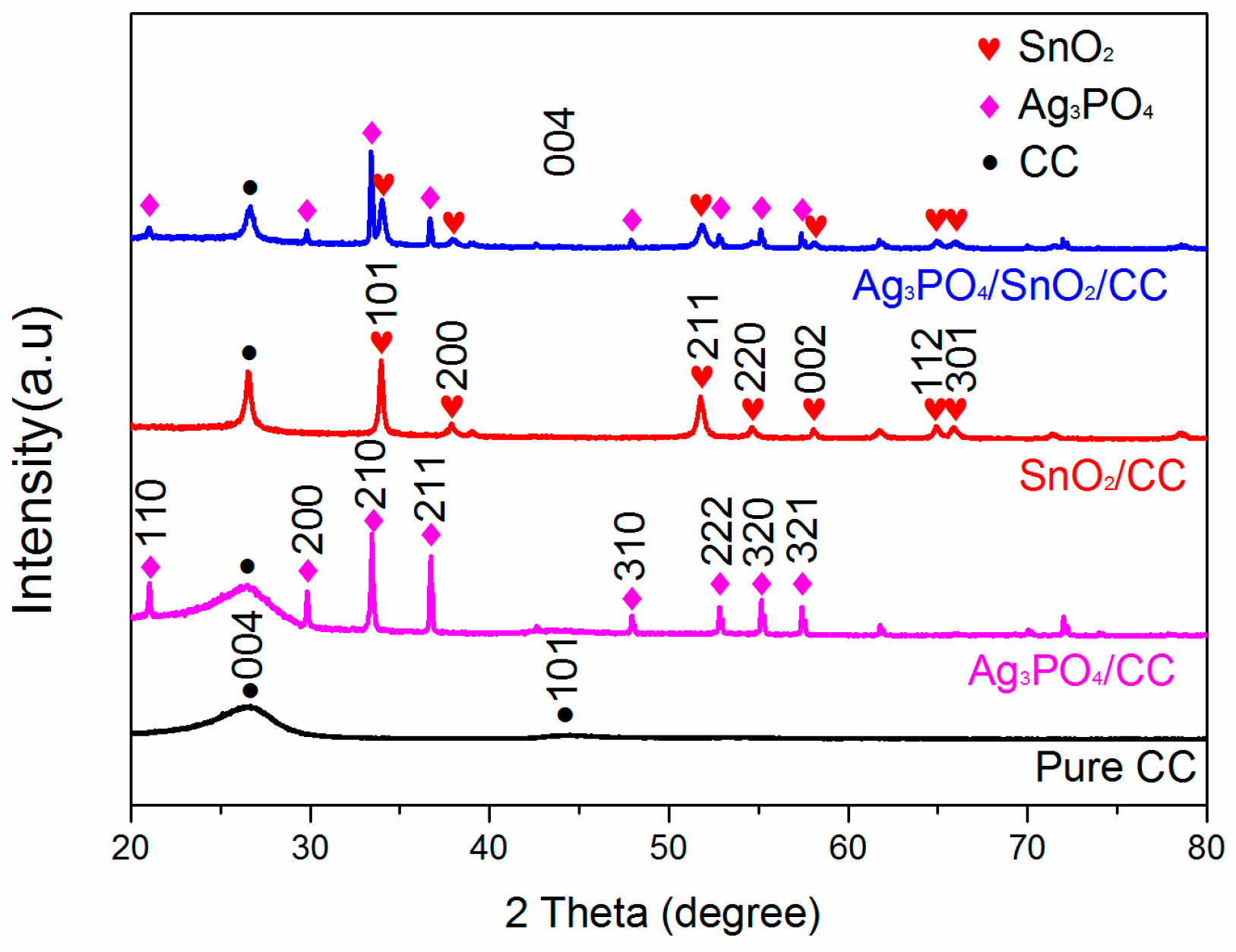
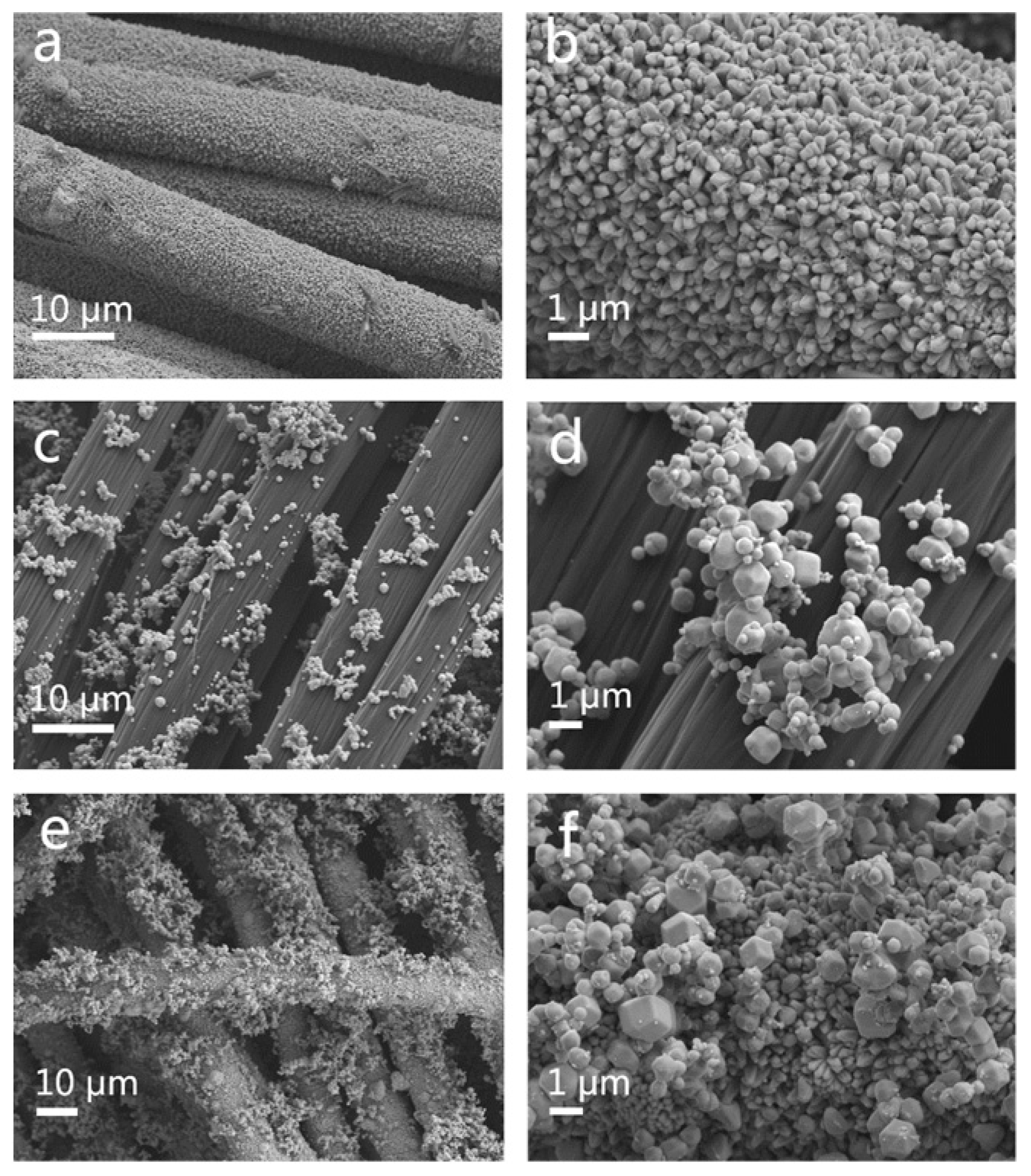

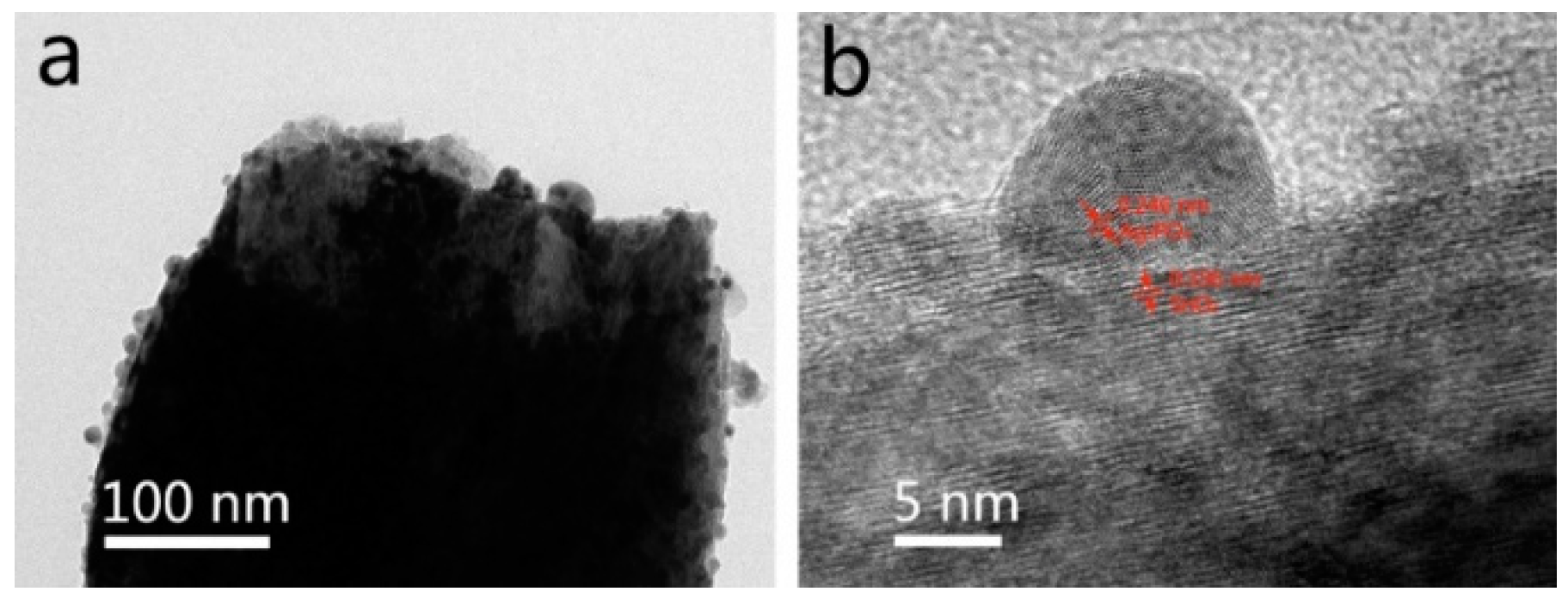
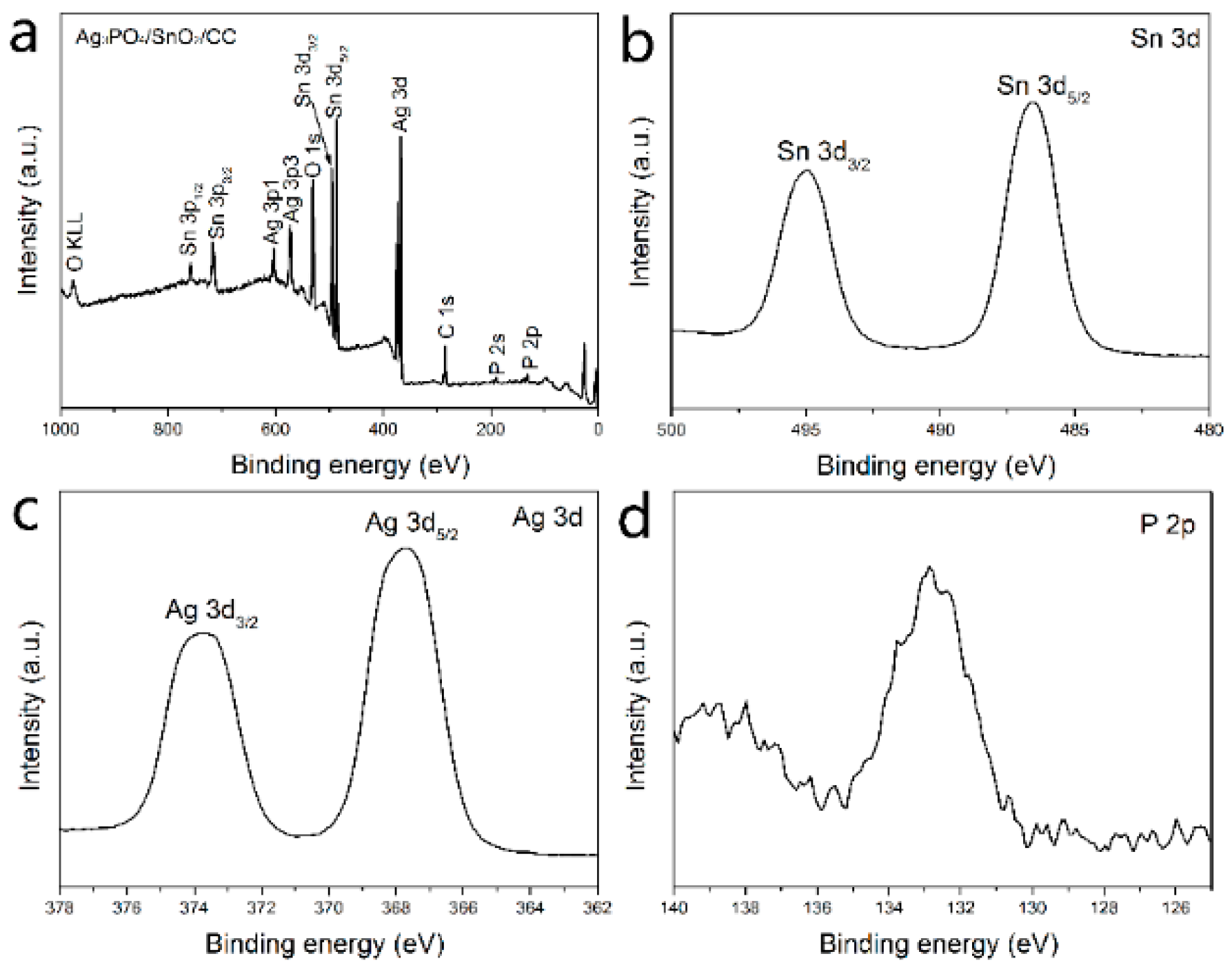
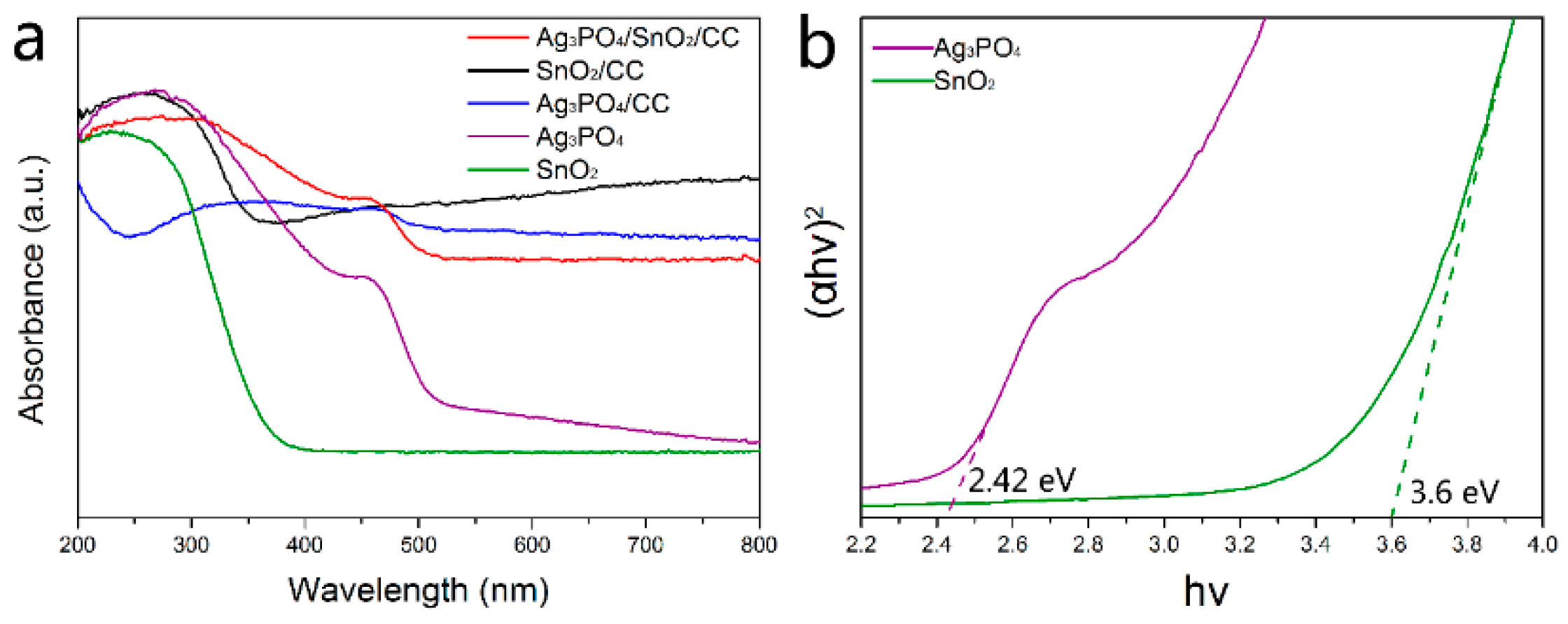
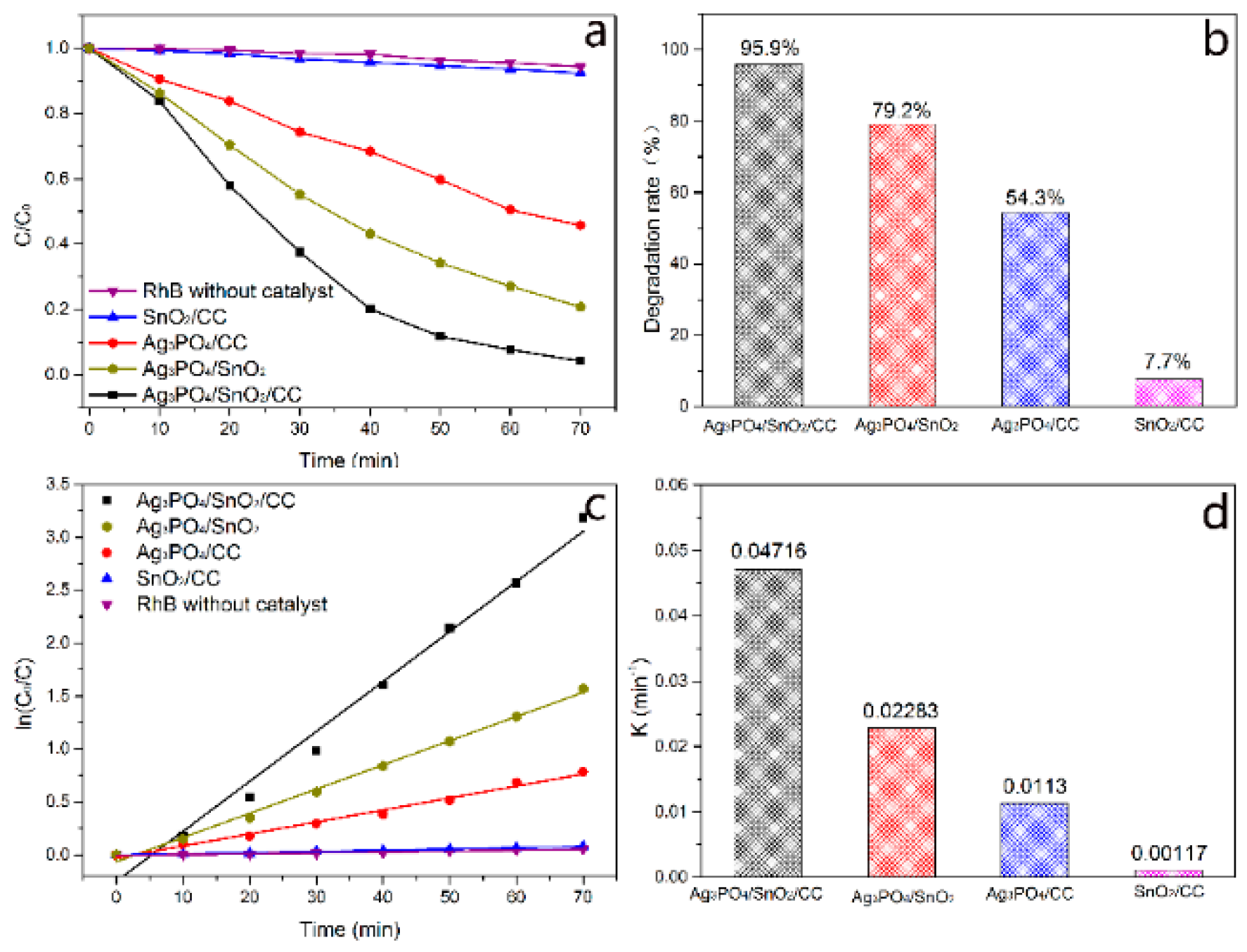
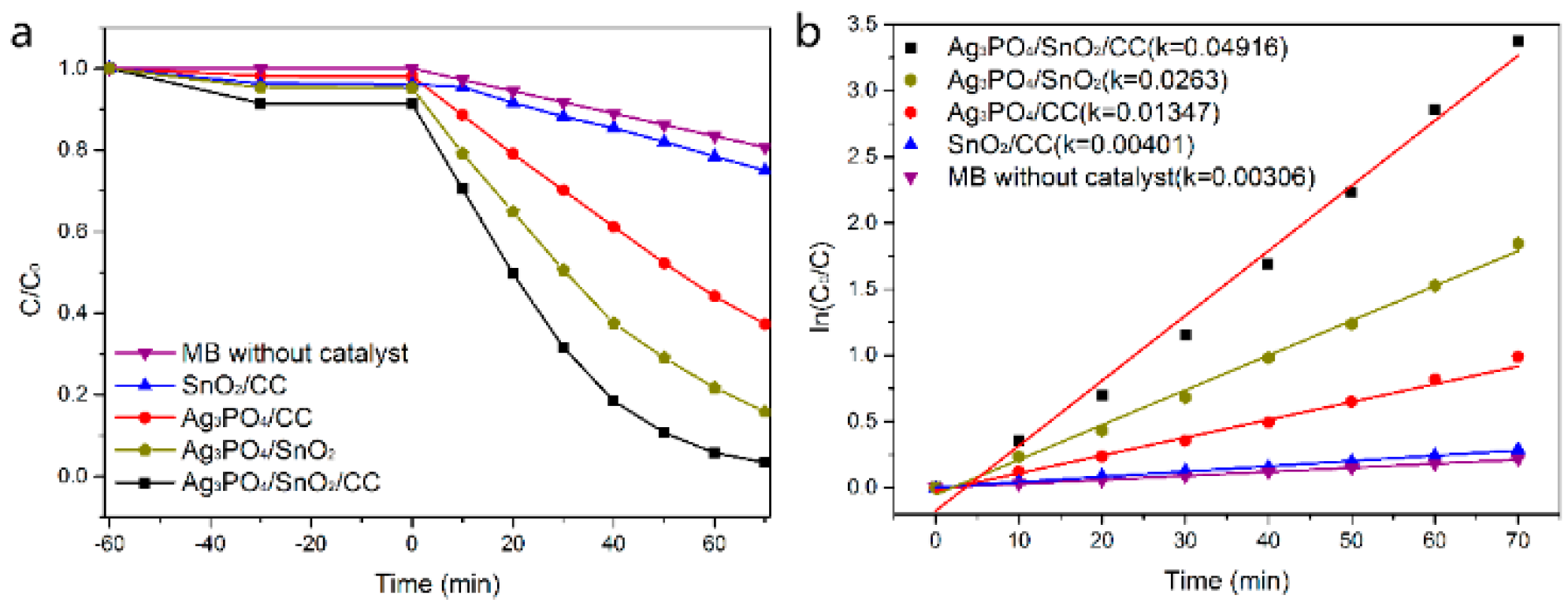
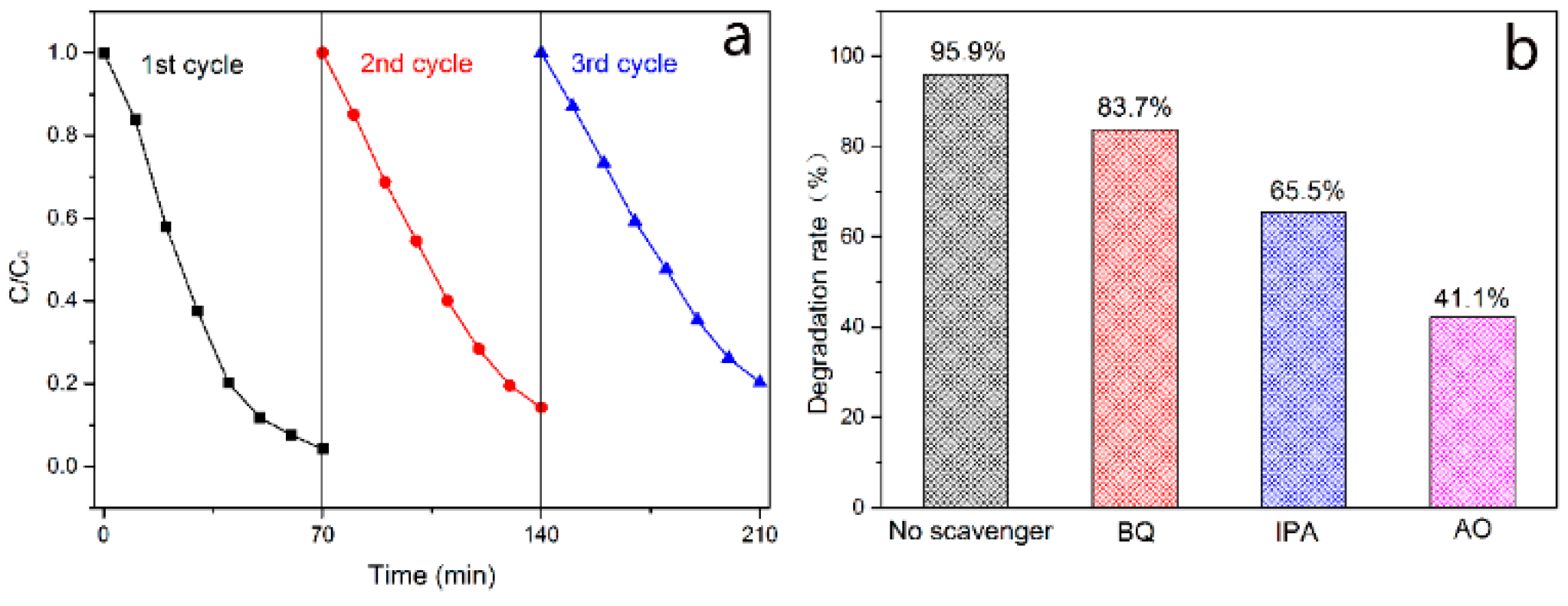
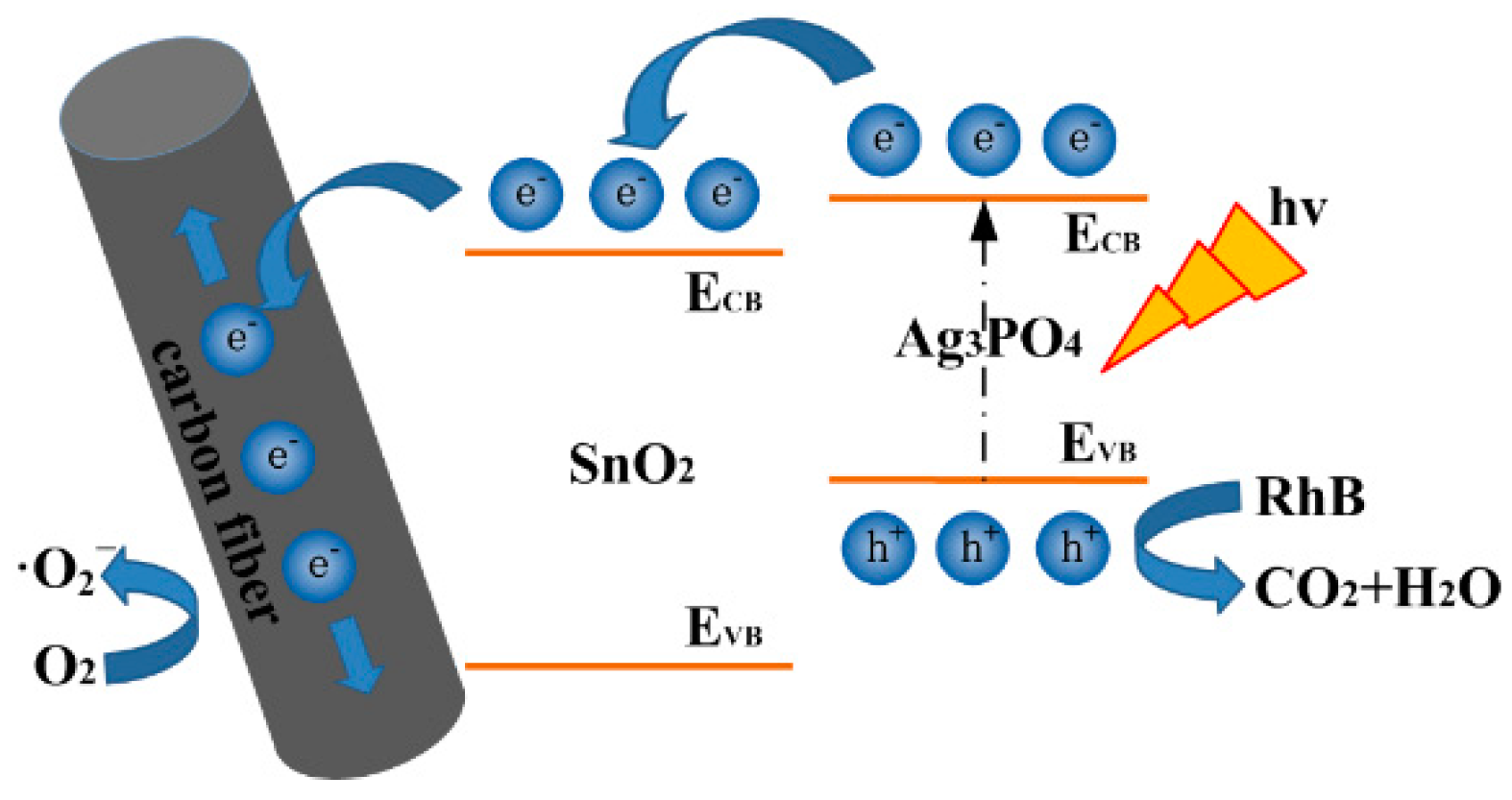
© 2020 by the authors. Licensee MDPI, Basel, Switzerland. This article is an open access article distributed under the terms and conditions of the Creative Commons Attribution (CC BY) license (http://creativecommons.org/licenses/by/4.0/).
Share and Cite
Liu, M.; Wang, G.; Xu, P.; Zhu, Y.; Li, W. Construction of Ag3PO4/SnO2 Heterojunction on Carbon Cloth with Enhanced Visible Light Photocatalytic Degradation. Appl. Sci. 2020, 10, 3238. https://doi.org/10.3390/app10093238
Liu M, Wang G, Xu P, Zhu Y, Li W. Construction of Ag3PO4/SnO2 Heterojunction on Carbon Cloth with Enhanced Visible Light Photocatalytic Degradation. Applied Sciences. 2020; 10(9):3238. https://doi.org/10.3390/app10093238
Chicago/Turabian StyleLiu, Min, Guangxin Wang, Panpan Xu, Yanfeng Zhu, and Wuhui Li. 2020. "Construction of Ag3PO4/SnO2 Heterojunction on Carbon Cloth with Enhanced Visible Light Photocatalytic Degradation" Applied Sciences 10, no. 9: 3238. https://doi.org/10.3390/app10093238
APA StyleLiu, M., Wang, G., Xu, P., Zhu, Y., & Li, W. (2020). Construction of Ag3PO4/SnO2 Heterojunction on Carbon Cloth with Enhanced Visible Light Photocatalytic Degradation. Applied Sciences, 10(9), 3238. https://doi.org/10.3390/app10093238




